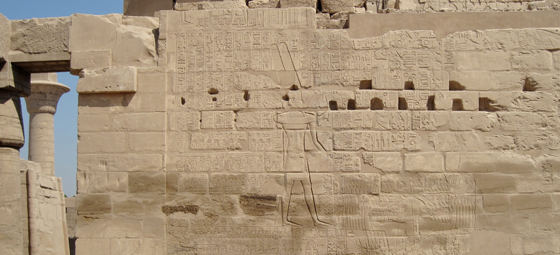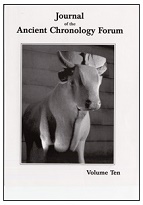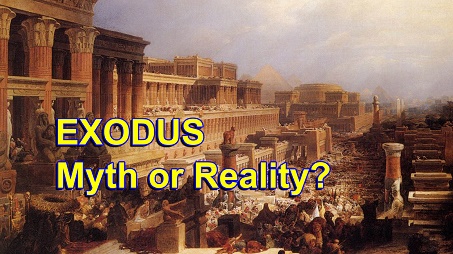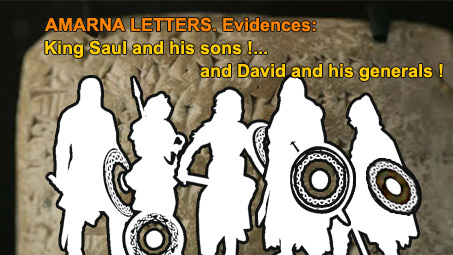
NEW Coherent CHRONOLOGY of Ancient History
Based on David Rohl's thesis and other independent experts. A NECESSARY REVISION OF THE CONVENTIONAL CHRONOLOGY.
.png)
"Chronology is the backbone of the history. Without exact chronology there can be no exact history". Edwin Thiele (The Mysterious Numbers of the Hebrew Kings pg.33)
"The seemingly daring intention to revise the standard chronology of ancient history is motivated by the evidence that some accounts of ancient history suffer from an excess of credibility". Moral Pérez G. (Revised Chronology of Ancient History pg.3)
"Recent research.. has revealed a number of chronological anomalies which throw the conventional scheme of history into serious doubt." John J. Bimson (JACF Journal of the Ancient Chronology Forum, vol.6 pg.19)
.png)
.jpg)
Consistent revised identification of King David and his Generals in EA 256!
(*) Mut-Bahlu: "Mutbaal means 'Man of Baal' and is identified with the biblical name Isbaal with the same meaning. Isbaal (also called Isboset) is the surviving son of King Saul who rules from Transjordan some time after his father's death on Mount Gilboa." (JACF Journal of the Ancient Chronology Forum, vol.6 pg.51)
(*) Ayab: "The name Ayab of EA 256 (A-ya-ab) should be understood as Ya-ab with the prefix aleph, and the name should read 'Yah [weh] is the Father', an exact match for the name of Joab [David's general]." (JACF vol.6 pg.52)
(*) Benilima: "Based on the context of the other figures in EA 256 and the distinctive features of the biblical character Benaiah, everything indicates that 'Benilima' ('son of the gods') would be an appropriate title for this man who he did extraordinary feats worthy of the gods, one of the most distinguished powerful men and bodyguard of King David." Moral Pérez G. (Revised Chronology of Ancient History) / "It may be that the Benenima of the Amarna letter EA 256 is in fact the biblical Benaia, and not Baana, as proposed by Rohl. Baana is a fleeting character." Charles N.Pope (Domain of Man)
(*) Tadua: "[In his Amarna Personal Names] Richard S. Hess interprets 'Tadua' with a Hurrian name with the same Hebrew meaning for Dud / Dawd ('the beloved'). We can argue that the name 'Dadua' was the Hebrew variant from 'Tadua' used by the author of the books of Samuel" Peter van der Veen (JACF vol.8 pg.38) / "The name David is transcribed as Dad for example in the Septuagint (Alexandrian codex) in I Kings 2:33. The original name was therefore Dud / Dad with the meaning 'the beloved (or favorite)'.". (JACF vol.6 pg.52)
(*) Yishuya: "As explained in JACF vol.6 pg.53, it is true that the name 'Yish-uya' agrees with the Hebrew 'Yish-ay' (Jesse: 'Yah Exist'), but it does not fit well with Jesse the father of David because he was already old. Rather, he would identify himself with another 'Jesse': the mighty Abishai ('Father Yah Exists') - nephew of David and brother of Joab-, since everything indicates that Jesse is a shortened form of Abishai. These two names are written in the Septuagint very similarly: 'Iessai' (Jesse) and 'Abessai' (Abishai). Consequently, all the characters mentioned in EA 256 would have a close historical relationship: on the one hand Isboset son of Saul, and on the other King David, his general Joab, and two of his closest and best men, Abishai and Benaiah." Moral Pérez G. (Revised Chronology of Ancient History)
.png)
Patterns of Evidence for the Exodus: from myth to reality
"Many scholars take the position that the epic stories of the Old Testament have an almost complete lack of foundation in the archaeological record (Joseph, Jacob and the Israelites in Egypt). Simply put, archaeologists and historians have been looking in all the right for the biblical stories, but in entirely the wrong time. It is now clear that the Exodus never happened in the reign of Ramesses the Great, as most scholars and all the Hollywood movies have insisted, but rather in a much earlier period: the Middle Bronze Age."


Key identification in the revised chronology
"There remain many uncertainties in the TIP [Third Intermediate Period], as critics such us David Rohl have rightly maintained; even our basic premise of 925 BC for Shoshenq's campaign to Jerusalem is not built on solid foundations." Erik Hornung - Ancient Egyptian Chronology (Handbook of Oriental Studies I, 2006, pg. 13)
"The identification of the biblical Shishak with Shoshenk I of the 22nd Dynasty .. has been one of the major factors in determining Egypt's high chronology. This paper questions the validity of the identification and proposes that it should no longer stand an as obstacle to a radical revision of the chronology of the Third Intermediate Period." John J. Bimson - Shoshenk and Shishak, A Case of Mistaken Identity? (JACF 6 pg.19)
.png)
This question is addressed in "Revised Chronology of Ancient History, New Evidences of the Historicity of the Bible"
FOREWORD to "Revised Chronology of Ancient History", Moral Pérez G.
It is undeniable that ancient history is a science that is difficult to pin down in the current of time, given the complexity of its study as we go centuries past. Writer C.W. Ceram made the following observation still valid today: "Anyone approaching the study of ancient history for the first time must be impressed by the positive way modern historians date events which took place thousands of years ago. In the course of further study this wonder will, if anything, increase. For as we examine the sources of ancient history we see how scanty, inaccurate, or downright false, the records were even at the time they were firts written. And poor as they originally were, they are poorer still as they have come down to us: half destroyed by the tooth of time or by the carelessness and rough usage of men." C.W. Ceram. El misterio de los hititas, Ediciones Orbis, 1985, pg. 69, 70.
Despite this, the desire of any good historian worth his salt will be to continue investigating and be willing to modify criteria according to the latest evidence and recent research, giving the archaeological record its proper place, but at the same time, being cautious and trying to solve the existing gaps, even innovating within the conventional chronology if necessary. As J.A.Wilson said: "The historian will accept his data at face value, unless there is a clear reason for distrust; but he must be ready to modify his acceptance as soon as new materials put the previous interpretation in a new light." J.A. Wilson. The World History of the Jewish People, 1964, vol. 1, pg. 280, 281.
The challenge facing the historian could be compared to the challenge of the detective who tries to clarify the facts of a crime and identify the murderer; the detective should be very careful when investigating the indications, because it will be the key to a correct opinion, being especially thorough with the initial tests, since it will serve as a basis to prop up other successive ones, thus allowing a consistent verdict. Much of this hard work is undoubtedly due to diligent researchers who over time have laid the foundations of historical science and others who currently continue to help unravel the historical maremagnum. However, such recognition does not carry the axiom that these foundations are immovable, since the large amount of new evidence accumulated in recent decades and the scholarly work of many modern authors has allowed us to broaden our understanding of this matter and to propose new hypotheses. Even the study of the most renowned subject in this field, archeology, can become a double-edged sword if the deductions obtained through it are overly trusted and rarely questioned, as it can lead to a totally wrong starting point. This could well be illustrated with the scene from the film "The lost ark" where Indiana Jones realizes that the Nazi enemies "are digging in the wrong place" by not having correctly interpreted the height of the a cane that, with a sunlight beam through a medallion, indicated the exact location in a map room. Scientific study has allowed us to have a true wealth of material evidence, although this has not increased the infallibility of its interpretation, as Merrill F. Unger reasoned when saying: "Scholars also must be extremely wary of attaching undue authority to archaeologists estimates of dates and interpretation of data. That the fixing of dates and the conclusions drawn from archeological findings often depend on subjetive factors is amply demonstrated by the wide divergences between competent authorities on these matters." Merrill F. Unger. Archaeology and the Old Testament, 1964, pg. 164.
For this reason, despite the fact that this science tries to maintain a purely objective point of view when studying the evidence that is unearthed, sometimes dependence on conventional chronology (which is often considered irrefutable) or the personal inclinations and ambitions of certain learned, which can lead to wrong reasoning. It is not surprising, then, that new and interesting proposals have emerged such as that of the renowned Egyptologist Kim Ryholt, who reorders the list of pharaohs of the Second Intermediate Period, an example of which the revisionist alternative, of course, has a place. Kim S.B. Ryholt. The Political Situation in Egypt during the Second Intermediate Period (1997).
Although of course, not all reviews are consistent or factual, such as Anatoly T. Fomenko's radical theory that ancient history actually begins in the Middle Ages and that Jesus Christ was a Byzantine emperor, or that of Ahmed Osman who identifies Moses with Pharaoh Akhenaten and Joshua with Tutankhamun, something totally implausible. Unfortunately, as Erik Hornung says in Ancient Egyptian Chronology, "we will always be exposed to such attempts" that undoubtedly imply "a rather lofty disrespect of the most elementary sources and facts and thus do not merit discussion." Ancient Egyptian Chronology (2006), Introducción de Erik Hornung, pg 15.
However, other theses are worth examining, such as Egyptologist David Rohl's New Chronology of the Ancient Near East (A Test of Time: The Bible -from Myth to History, 1995 / The Lost Testament: From Eden to Exile -The Five-Thousand-Year History of the People of the Bible, 2002) because, although it does not enjoy acceptance in academic Egyptology, it presents a surprising synchronism between the Mesopotamian, Levantine, Egyptian and Old Testament chronologies. Even among his detractors are comments such as Chris Bennett's, which suggests that the rejection generated is inappropriate, since "there is a world of difference" between "popular radicalisms" (Fomenko, Osman and others) and Rohl's intellectual standing who "has a considerable mastery of his material." Chris Bennett. "Temporal Fugues". Journal of Ancient and Medieval Studies XIII (1996).
Still, some may wonder what justifies the seemingly daring intention to revise the standard chronology of ancient history if it is widely accepted and has been taught for decades. The reason lies precisely in that: the evidence that some approaches to ancient history suffer from an excess of credibility. It is worth remembering that what is lavishly taken sometimes tends to be taken for granted as true, although time and time again it has been shown that widespread opinion on an issue is not a reliable rule of thumb for measuring truth, nor is it necessarily correct. Therefore, what is postulated here, although it does not intend to discredit the hard work of scholars in the matter, nor to question all the historical science, it does call attention to the fact that certain specific periods need a revision due to a reason of paramount importance: all indications suggest that such periods... "have been placed in the wrong place!" The length of the "cane" or measuring stick of Egyptian chronology as the fulcrum of the temporal scheme -fixed at the dawn of Egyptology in the 19th century- is clearly exceeded and inflated, something long recognized by many chroniclers. But in addition to that, it seems that a fundamental question is evaded that will be analyzed in detail later: it is not only necessary to shorten the length of some Egyptian dynasties, but also to correct certain pivot dates or axis dates that have been incorrectly established on the which rests the chronological mismatch. Certainly, there is still a lot of fabric to cut, although some ultra-Orthodox insist on intimidating these new researchers by calling them "charlatans" who "try to undermine the respectable disciplines of Egyptology." Frank Yurco. Biblical Archaeology Review Julio/Agosto 1997 pg.8-10.
But whoever is honest and objective will recognize that the study of this matter is not exactly static and that more and more sources are available and have better access to them outside the private sphere, which has allowed historical doctrine not to be an exclusive guideline from an elitist group, but more and more scholars can capture new evidence and contribute their conclusions, thus obtaining a wealth of favorable information to unravel the puzzle. Knowing the past well influences our way of seeing the present and the future; Understanding our origins has great repercussions in the concept of ourselves and in the humanity in general, reason why the investigation should be exhaustive and avoid conformist attitudes if there are still gaps of misunderstanding and dark ages. It is very likely that when the moment when our history enjoys considerable coherence, the human being feels more motivated to straighten the course of his own becoming. Sturt W. Manning made a curious comment regarding the above: "Chronology and dating in academic archeology and ancient history are subjects avidly practiced by a few, regarded as a necessary but comprehensively boring evil by the majority [...], the study of chronology is unpleasant, detailed, and difficult, and lacks intellectual status and élan [vital spirit]. [...] Thus, where possible, the academic establishment likes to find some study on chronology to be effectively definitive... It is only when some iconoclast, or outsider, challenges the whole structure, tries of 'beat the boffins', that general academic attention returns to the chronology (e.g. Peter James with Centuries of Darkness 1991, or David Rohl with A Test of Time 1995)." Sturt W. Manning. Classical Review vol. 47 n.2 (1997) pg. 438-439.
All in all, many reject these "outsiders", because in their theses they include an integration of biblical and secular sources, something that some, like the theologian Thomas L. Thompson, consider that "it is not only doubtful but totally ridiculous." (Thomas L. Thompson. How myth became history. The Sunday Times, 13 October 2002.) Rohl himself explained his point of view on this matter in The Lost Testament (2002): "Is the Old Testament history or myth? The only way to answer that question is to investigate the biblical stories using the archaeological evidence, combined with a study of the ancient texts of the civilisations which had a role to play in the Bible story. But this has to be done with an open mind. In my view the biblical text -just like any other ancient document- should be treated as a potentially reliable historical source until it can be demonstrated to be otherwise." (The Lost Testament, pg.3) Rohl previously said in A test of time (1995): "did not originally set out to challenge our current understanding of the Old Testament narratives. This has come about simply because of the need to explore the ramifications of my TIP [Egyptian Third Intermediate Period] research. I have no religious axe to grind - I am simply an historian in search of some historical truth." (A Test of Time, pg.11).
On the other hand, it is no less true the fact that some are so interested in fitting into the biblical text characters and places discovered by archeology, that they even resort to bizarre explanations even if they do not make complete sense. Finding the balance between myth and reality is tricky, while it is easy to get carried away by sensationalism and not stick to reality. Despite this, the Bible is a recognized work of value that deserves an opportunity for impartial analysis, given the reliability it has shown over time in its accuracy in providing historical and geographic data. Although its historical rigor has been questioned for decades, more and more voices are heard about the wisdom of being cautious and not taking such accusations for granted, because, as Werner Keller says in his well-known book: "In the face of the enormous abundance of authentic and I'm sure this idea is becoming more and more [...] evident to me: The Bible was right!." Introducción de "Y la Biblia tenía Razón", Werner Keller.
Therefore, it would be unfair to exclude and discredit what is considered the historical document par excellence, either due to prejudice, erroneous interpretation of certain passages or due to the misuse that religion has made of it, in the same way that it would be unfair to discredit the science for the fateful use that has sometimes been made of knowledge, such as inventing the atomic bomb. Therefore, in the present exposition the biblical text has been taken as "potentially reliable" and as a useful comparative guide -along with the material evidence- to determine from which "pillar" or "column" of the "building" of the standard chronology of ancient history, it deserves a readjustment. Although it is true that many of those pillars (axis dates of general acceptance) are well grounded in historical science, everything indicates that as we go back in time, there comes a time when certain axis or pivot dates are misplaced and "the structure" begins to fail. The objective of this report is to start from periods (B.C.) that are well established and travel back to the past to locate the mismatch. The reader will no doubt want to examine the arguments "with an open mind" by letting them speak for themselves. Virtually nothing new is provided, as much of the information and sources collected here are widely available and freely accessible. Nor is it an infallible and definitive proposal, but it is a contribution, in some way, to the fact that the chronology of ancient history is not a cold and mechanical discipline, but a science that manages to satisfy our thirst for answers, a different approach that helps to hear the increasingly widespread demand - in light of the new evidence put on the table - for a necessary revision of the conventional chronology.
·····························
·····························
INDEX
INTRODUCTION
CHAPTER 1: WHERE IS THE CHRONOLOGICAL DISCREPANCE?
CHAPTER 2: GENERAL CONSEQUENCES OF THE DIVERGENCE
CHAPTER 3: PLACING THE ISRAELITE EXODUS AND CONQUEST AT THE RIGHT PERIOD
CHAPTER 4: AMARNA LETTERS: REFERENCES TO SAUL, DAVID AND THEIR ENVIRONMENT!
CHAPTER 5: IS SHESHONQ I (DIN.22) THE BIBLICAL SHISHAK?
EPILOGUE: THE 1000 YEARS OF THE DISCORD
·····························
·····························

·····························

·····························
 Colin Renfrew.jpg)
 John Bimson.jpg)
 David Rohl.jpg)




